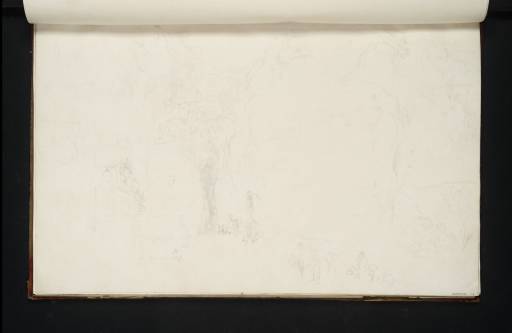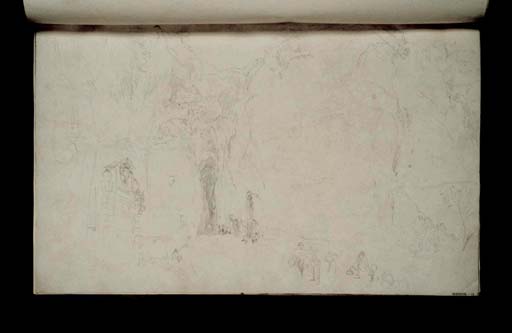Joseph Mallord William Turner The Grotto of Posillipo, Naples 1819
Image 1 of 2
Joseph Mallord William Turner,
The Grotto of Posillipo, Naples
1819
Joseph Mallord William Turner 1775–1851
Folio 11 Recto:
The Grotto of Posillipo, Naples 1819
D16098
Turner Bequest CLXXXVII 11
Turner Bequest CLXXXVII 11
Pencil on white wove paper, 255 x 403 mm
Inscribed by John Ruskin in blue ink ‘11’ bottom right, descending right-hand edge
Stamped in black ‘CLXXXVII 11’ bottom right
Inscribed by John Ruskin in blue ink ‘11’ bottom right, descending right-hand edge
Stamped in black ‘CLXXXVII 11’ bottom right
Accepted by the nation as part of the Turner Bequest 1856
References
1909
A.J. Finberg, A Complete Inventory of the Drawings of the Turner Bequest, London 1909, vol.I, p.555, as ‘The Grotto of Posilipo’.
One of the most popular subjects for British artists in Naples was the Grotto of Posillipo (today known as the Crypta Neapolitana), a tall, narrow tunnel built through the Posillipo Hill during the first century BC.1 An impressive feat of ancient engineering, legend had it that the tunnel been magically created by the classical poet, Virgil, whose villa was said to be nearby. Still in use until the late nineteenth century, it represented not only a must-see tourist attraction, but also a key thoroughfare for travelling to Pozzuoli and Lake Agnano, west of the city. A partial collapse during the 1920s rendered the passageway impassable, and access through the hill is now achieved through two adjacent modern tunnels.
Turner’s study depicts the Naples entrance of the Grotto, found near the western end of the Chiaia district (in present-day Parco Vergiliano). His treatment follows the standard eighteenth-century tradition of the subject by showing a frontal view of the dark, cavernous entrance amidst the rocky hill face. Visible on the left-hand side of the opening is the so-called Tomb of Virgil, whilst in the left-hand foreground is a stone monument set into the wall. The inclusion of figures, dwarfed by the height of the tunnel helps to establish a sense of scale and monumentality. Turner would have been well aware of this pictorial convention, having made a small pen-and-ink copy of a view after John ‘Warwick’ Smith (1749–1831) in the Italian Guide Book sketchbook (Tate D13969; Turner Bequest CLXXII 20a, third from bottom left).2 Furthermore, he would almost certainly have known James Hakewill’s drawings of both ends of the tunnel, the Pozzuoli entrance of which formed the subject of an engraving in Hakewill’s Picturesque Tour of Italy (1820).3 Several related on-the-spot sketches can be found in the Gandolfo to Naples sketchbook (Tate D15659–D15661; Turner Bequest CLXXXIV 51a–52a). See also the studies of Virgil’s tomb in the Pompeii, Amalfi, Sorrento, Herculaneum sketchbook (Tate D15865; Turner Bequest CLXXXV 68).
Nicola Moorby
April 2010
Images of the tunnel include, for example, Thomas Jones (1742–1803), The Grotto of Posillipo, oil on paper, 1782 (Gere Collection), William Pars (1742–1782), The Grotto at Posillipo (Birmingham City Museum and Art Gallery) and Francis Towne (1740–1816), The Grotto at Posillipo, watercolour, 1781 (British Museum), all reproduced in colour in Anna Ottani Cavina, Un Paese Incantato: Italia Dipinta da Thomas Jones a Corot, exhibition catalogue, Galeries nationales du Grand Palais, Parigi and Palazzo Te, Mantova, Italy 2001, nos.38–40, pp.60–3, and Francis W. Hawcroft, Travels in Italy 1776–1783: Based on the ‘Memoirs’ of Thomas Jones, exhibition catalogue, Whitworth Art Gallery, Manchester 1988, nos.132–5, pp.111 and 116.
See also John ‘Warwick’ Smith (1749–1831), Grotto of Pausilippo 1778–9, watercolour (Tate, T08492).
How to cite
Nicola Moorby, ‘The Grotto of Posillipo, Naples 1819 by Joseph Mallord William Turner’, catalogue entry, April 2010, in David Blayney Brown (ed.), J.M.W. Turner: Sketchbooks, Drawings and Watercolours, Tate Research Publication, December 2012, https://www


